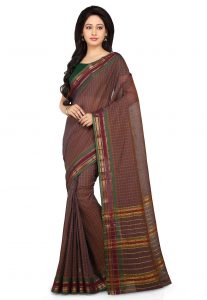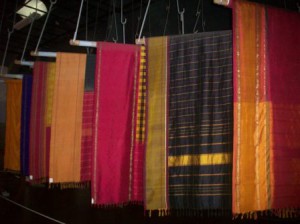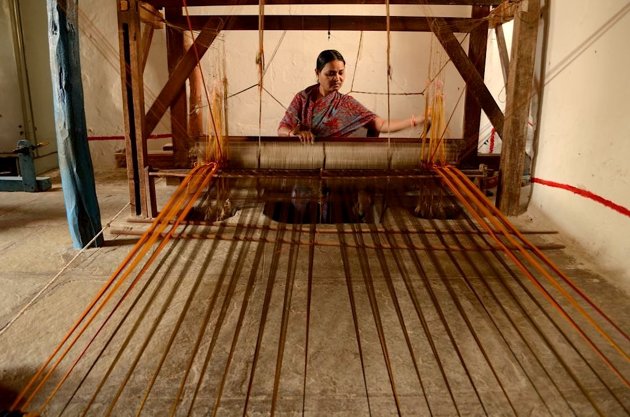
Narayanpet Saree
There is a distinct style attached to the Narayanpet sarees, the sarees have a checked surface design with embroidery and the border or pallu have intricate ethnic designs such as a temple. The borders and pallu of the Narayanpet Silk saree are given a contrasted look with small zari designs.
Origin and History
Going by historical records, in 1630 AD, the Maratha king, Chatrapati Shivaji traveled to the Narayanpet region where he camped for a while. When he continued on his journey, a few weavers stayed behind.
These were the weavers who started producing the Silk sarees with a distinct style of design which came to be known as Narayanpet Silk sarees. No wonder then, courtesy the weavers who migrated from the Maratha region to Narayanpet, there is lot of Maharashtrian influence seen in Narayanpet Silk sarees.
Later on, under the rule of Lokapalli Sansathanam, the production of Narayanpet Silk and Cotton sarees increased dramatically.
Present Day Scenario
For producing the Narayanpet sarees, vegetable dyes are used. This is a unique process where eight sarees are made at one go on a loom. Thus instead of the standard 7 yards of fabric being mounted on the loom, 56 yards of Silk are mounted on the loom at a single time.
After the degumming, dyeing and drying process, the actual weaving starts. In the case of Cotton sarees, it takes one day to complete a saree, whereas a Silk saree takes 4-5 days to be completed.
In 2012, Narayanpet sarees got its Geographical Indicator (GI) registration with the government of India.
Today Narayanpet Silk sarees are known for their easy affordability. A typical Narayanpet silk saree can be bought for Rs. 1000/- to Rs. 6000/-
Sources of Inspiration
The state of Andhra Pradesh, especially the Mehboobnagar region is known for it’s extreme climate. It is extremely hot in summer and cold in winter. If one has to deduce, the extremities of the weather could well have prompted the creation of the style of Narayanpet Silk sarees which is beautiful and rich to look at and is comfortable to wear round the year because of it’s light weight.
Faces behind the Fabric
The early weavers who settled down in the Narayanpet region in the 17th century are the pioneers of this art. The skill has been passed down from generation to generation. The entire weaver community involved in this art is located only in Narayanpet.
Innovations
There are eight threads used in weaving the saree at the borders which help in strengthening the fabric.
Occasion dressing

Handloom Cotton Narayanpet Saree
Narayanpet Silk sarees with their strong Maharashtrian influence are quite popular in Maharashtra and are worn during auspicious occasions. They are also used as an offering to their holy deity. In Andhra Pradesh also, Narayanpet Silk sarees are sought after along with the Pochampalli Ikat sarees and the Uppada Silk sarees from the east Godavari region.
Suitability
Courtesy the fact that these sarees are light in weight, they can be worn quite comfortably through the year.
Maintenance
Narayanpet Silk sarees can be gently hand washed in cold water with a mild detergent.
Global Appeal
With designers like Shravan Ramaswamy acting as guardian angels and showcasing the Narayanpet silk sarees, the weavers have been hugely benefited by the surge in demand.
At any handloom or silk exhibition, Narayanpet silk sarees are a definite part of the showcase around the globe.
The popularity of Narayanpet sarees is enhanced by the fact that amongst all the Silk garments, this is the one which is most easily affordable. In recent times, even, designer boutiques have started stocking and selling Narayanpet silk sarees.
Interesting Facts and Comparisons
- Because of their light weight and the signature design of contrasting border and pallu coupled with the small zari designs on the borders, Narayanpet Silk sarees are often compared to Irkal sarees.
- The Sarees always come with contrasting borders.
Reference
Categories: Textiles


